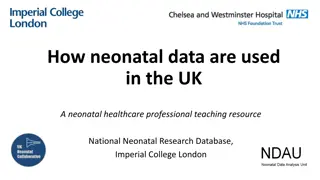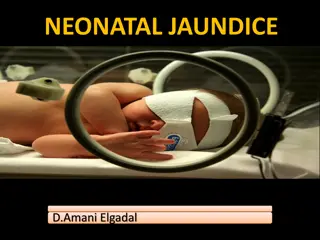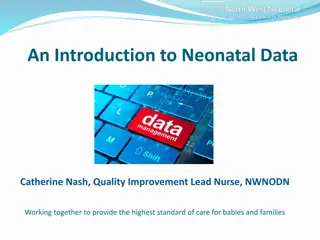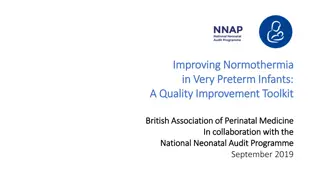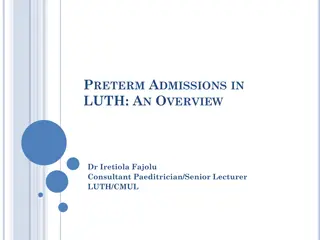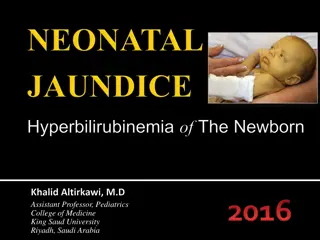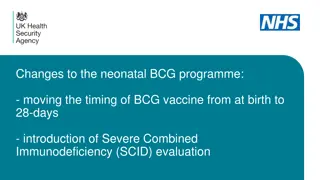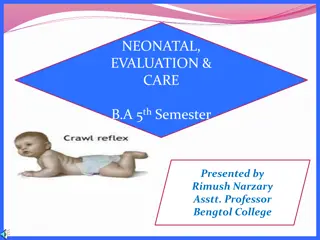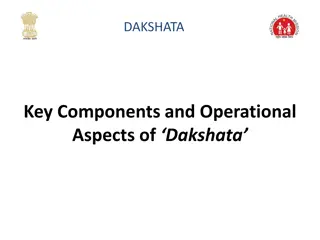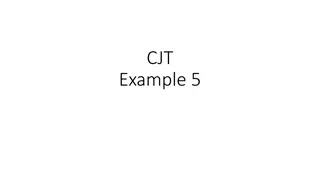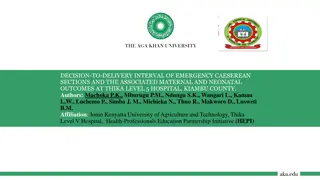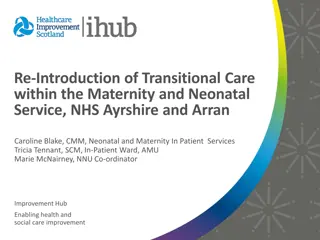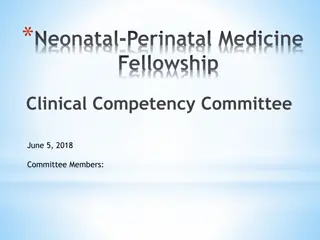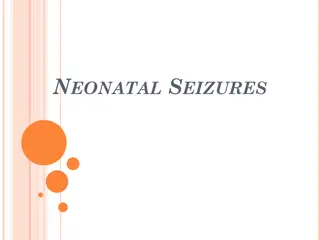Clinical Judgement Test: Neonatal Foal Case Presentation and Assessment
This case involves a clinical judgement test scenario of an 8-hour-old Standardbred colt foal presenting with recumbency, weakness, and abnormal blood parameters. The foal's history suggests possible placental insufficiency and dysmaturity, leading to pulmonary dysfunction and other complications. Initial assessment findings include abnormal vital signs, hematological abnormalities, and arterial blood gas disturbances. Further information and examination details are to be presented during the assessment. Discussion points include the recognition of dysmaturity despite prolonged gestation, the impact of placental insufficiency, and the potential complications such as aspiration pneumonia and IUGR. The scenario challenges the examiner to identify primary issues and outline a management plan based on the presented findings.
Download Presentation

Please find below an Image/Link to download the presentation.
The content on the website is provided AS IS for your information and personal use only. It may not be sold, licensed, or shared on other websites without obtaining consent from the author.If you encounter any issues during the download, it is possible that the publisher has removed the file from their server.
You are allowed to download the files provided on this website for personal or commercial use, subject to the condition that they are used lawfully. All files are the property of their respective owners.
The content on the website is provided AS IS for your information and personal use only. It may not be sold, licensed, or shared on other websites without obtaining consent from the author.
E N D
Presentation Transcript
CJT Example 3
Clinical judgement test Aims Test clinical application and ability to justify clinical decision making Knowledge of disease pathophysiology Knowledge of the evidence base on which decision are made References As with previous cases reference are not provided but reviewing this evidence is considered useful in your preparation for examination.s.
SIGNALMENT PRESENTING SIGNS HISTORY 8 hours old Standardbred colt foal intended for racing. Recumbent and unable to stand Unattended foaling 10 days prior to calculated term (day 320) Owner reports placenta looked yellowish. Vaccination history unknown. Mare had live, full term foal two years ago, late abortion last year. Owner has fed foal some colostrum from a bottle, poor suckle reflex noted. Foal has not stood up. Case Recumbent. HR 48, 2/6 sysyolic murmur on LHB Weak peripheral pulses and cold extremities Membranes pale grey, CRT 4 seconds Rectal temperature - below threshold No menace, weak withdrawal reflex, no entropion Joints and umbilicus normal by palpation Soft hair coat, bulging forehead, normal ear position Physical examination Result Result Reference Reference Result Result Reference Reference PCV (l/l) 0.23 0.32-0.46 CK (IU/l) 2770 400-909 GLDH (IU/l) 10.56 8.0-43.0 110-190 Haemoglobin (g/L) 83 GGT (IU/l) 24 18-43 WBC (x109/L) 2.3 4.9-11.7 SAA (mg/l) 5 0-36.6 Neutrophils (x109/L) 1.0 3.4-9.6 Fibrinogen (g/l) 3.0 0.3-3.9 Band neutrophils (x109/L) 0.5 0-0.1 Protein (g/l) 25 43-81 Lymphocytes (x109/L) 0.7 Albumin (g/l) 20 25-36 0.7-2.1 Monocytes (x109/L) 0.3 0.1-0.4 Creatinine (umol/L) 1061 106-380 Eosinophils (x109/L) 6.7-12.9 0.0 0-0.02 Glucose (mmol/l) 1.4 FURTHER INFORMATION WILL PRESENTED DURING THE COURSE OF THE EXAMINATION
Arterial blood gas analysis Results Reference PaCO2 (mmHg) 65 36-46 PaO2 45 80-112 Lactate (mmol/L) 16 <2 Saturation of oxygen,s02, (%) 85% >93 4
stop THE REMAINDER OF THIS CASE WOULD BE PRESENTED DURING YOUR ASSESSMENT
Question 1 Discuss your initial assessment of this foal?(40) Prompt: what are your primary problems how will you manage these Unacceptable The good generalist A new diplomate The advanced diplomate Does not recognise as dysmature Clinical signs of dysmaturity but unable to rationalise gestational length Recognises dysmature despite prolonged gestation Dysmaturity despite prolonged gestation Resulting from placental insufficiency and likely a result of placentitis (high creatinine) resulting in IUGR Lung disease attributed only to aspiration Pulmonary dysfunction with hypoxia and hypercapnia does not relate these to radiographic findings or dysmaturity Pulmonary dysfunction as a result of atelectasis with possible exacerbation due to aspiration pneumonia due to bottle feeding with poor suckle reflex Pulmonary dysfunction (hypoxia and hypercapnia) as a result of atelectasis (from radiograph) due to inadequate lung maturation Discusses steroid release during disease and lung maturation May be exacerbated by aspiration pneumonia secondary to poor suckle reflex sepsis through aspiration/ umbilicus Sepsis is identified without linking to FTP or recumbency Recognises sepsis based on blood results and predicts FTP Identifies likely sources of sepsis Mentions glucose Sepsis and FTP (not properly nurses) Not stood Uterine pathology Link to laboratory findings despite normal SAA Identifies likely sources of sepsis Hypoglycaemia intake Focuses on lactate and creatinine recumbency due to neonatal encephalopathy not hypotension Discusses hyperlactaemia as evidence of hypovolaemia Links HR to K+ Recognises hyperlactaemia is more than just hypovolaemia Discusses bradycardia potential causes recognises likely cause of recumbency Hyperlactaemia likely from hypovolaemia, hypoventilation (type A) and sepsis (type B) Bradycardia not related to hypotension ?K rarely vagal Relates to recumbency while also discussing encephalopathy
You diagnose the foal as being Dysmature Hypoxic and hypercapnic with lung dysfunction related to atelectasis secondary to dysmaturity Septic with failure of passive transfer Hypovolaemia Bradycardia serum potassium concentration is normal How will you initially manage these problems
Question 2 Describe your initial stabilisation of this foal (40) Unacceptable The good generalist A new diplomate The advanced diplomate Relies on pharmacological interventions (doxapram / caffeine) without oxygen Intranasal oxygen described in management of hypoxia. Discussion of caffeine Critically evaluates need for respiratory support and limitations of pharmacological support. Recommends ventilation with limited detail. Primary management of lung dysfunction should be through ventilation, discusses advantages of PEEP / SIMV. Discusses airway drying and increase risk of disease Nutritional management relies upon enteral feeding Able to discuss concerns with enternal nutrition but formulation of pareneteral fluid plan is limited Nutrional support using IV glucose, justified on basis on poor intestinal perfusion. Justifies indications for TPN Nutritional support : Develops robust nutritional plan using TPN or glucose and insulin predicting IR able to justify and consider risks (thrombosis) Reliance on antibiotics administration using high priority CIAs without being able to justify their use Recommends plasma Recommends plasma and justifies source Able to recommend rational antibiotic regime vs G+ and G- sepsis and volume of distribution Addresses relevant dosing for foal Considers important of 3rd generation cephalosporins Sepsis: Addresses FPT addressing advantages of hyperimmune fresh frozen plasma in discusses advantages over maternal plasma. Antibiotic choice a balance on predicted susceptibility and resistance. Discusses emerging published resistance in foals Formulates an antibiotic plan based on broad spectrum Formulates plan for crytalloids and colloids with limited discussion of benefits No mention of pharmacological agents Discusses crytalloid and colloid plan Discusses crystalloid therapy plan and use of pressors in the event of lack of response but does not discuss CIRCI and use of C/S Cardiac :Discuss and critiques crystalloid bolus, and colloids. If no improvement, pressors (dobutamine, vasopressin) corticosteroids if resistant to therapy. Discusses evidence for use including CIRCI Management of bradycardia vagalytics unlikely to be effective norepi/ pacing Limited discussion of pressors Limited mention of management of bradycardia reliance of vagolytics Discusses pharmacological management of bradycardia although atropine unlikely to be effective
After initial stabilisation 4 days later QAR. Occassionally ambulating and has nursed from mare with help. Still on intranasal O2 at 10L/min but blood gas improved. T 39.6 HR 108 RR 52, mild amount of mucoid nasal discharge Joints normal on palpation Umbilicus slightly moist and dribbles during urination Mucous membranes pink and moist Ultrasound shows... 11
Question 3 Discuss and justify your management(20) Unacceptable The good generalist A new diplomate The advanced diplomate Suggests septic without evidence and no mention of patent urachus Unable to identify all structures able to identify all structures able to identify all structures Persistent urachus as hypoechoic fluid can be noted in umbilical stump Can be due to infection but excessive handling and abdominal pressure can also cause patency uneven size of arteries is normal at this age but could also be sign of early infection Suggests likely septic without robust justification Recognises persistent urachus but does not discuss likely causes Diagnosis of patent urachus Suggests likely septic focus but considers other factors Gives very superficial therapy descriptions not discussing balance of need for medical or surgical intervention or focuses need based on minor factors (eg anaesthetic risk) Unable to justify choise of medical or surgical intervention but indicates both effective and limited clinical detail of intervention. Bases decision on minor factors (eg anaesthetic risk/ adhesions) rather than global outcomes Justifies medical or surgical outcomes based on clinical experience of selected sources of evidence of outcomes (more than anaesthetic / surgical risk) Gives details of therapy that are robust and appropriate Justifies medical or surgical intervention based on evidence of outcomes being able to give overview of data Gives details of therapy that are robust and appropriate
Scores Question No answer (0) Unacceptable (2) Good generalist (4) New diplomate (6) Experienced diplomate (10) 1 1 1 1 2 2 2 2 3 3


